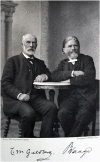Cato Guldberg and Peter Waage, the history of the Law of Mass Action, and its relevance to clinical pharmacology
- PMID: 26174880
- PMCID: PMC4693570
- DOI: 10.1111/bcp.12721
Cato Guldberg and Peter Waage, the history of the Law of Mass Action, and its relevance to clinical pharmacology
Abstract
We have traced the historical link between the Law of Mass Action and clinical pharmacology. The Law evolved from the work of the French chemist Claude Louis Berthollet, was first formulated by Cato Guldberg and Peter Waage in 1864 and later clarified by the Dutch chemist Jacobus van 't Hoff in 1877. It has profoundly influenced our qualitative and quantitative understanding of a number of physiological and pharmacological phenomena. According to the Law of Mass Action, the velocity of a chemical reaction depends on the concentrations of the reactants. At equilibrium the concentrations of the chemicals involved bear a constant relation to each other, described by the equilibrium constant, K. The Law of Mass Action is relevant to various physiological and pharmacological concepts, including concentration-effect curves, dose-response curves, and ligand-receptor binding curves, all of which are important in describing the pharmacological actions of medications, the Langmuir adsorption isotherm, which describes the binding of medications to proteins, activation curves for transmembrane ion transport, enzyme inhibition and the Henderson-Hasselbalch equation, which describes the relation between pH, as a measure of acidity and the concentrations of the contributory acids and bases. Guldberg and Waage recognized the importance of dynamic equilibrium, while others failed to do so. Their ideas, over 150 years old, are embedded in and still relevant to clinical pharmacology. Here we explain the ideas and in a subsequent paper show how they are relevant to understanding adverse drug reactions.
Keywords: Cato Guldberg; Law of Mass Action; Peter Waage; chemical equilibrium; dose-response relationship, drug.
© 2015 The British Pharmacological Society.
Similar articles
-
The mass action equation in pharmacology.Br J Clin Pharmacol. 2016 Jan;81(1):41-51. doi: 10.1111/bcp.12810. Epub 2015 Dec 21. Br J Clin Pharmacol. 2016. PMID: 26506455 Free PMC article. Review.
-
The Hill equation: a review of its capabilities in pharmacological modelling.Fundam Clin Pharmacol. 2008 Dec;22(6):633-48. doi: 10.1111/j.1472-8206.2008.00633.x. Fundam Clin Pharmacol. 2008. PMID: 19049668 Review.
-
Algorithms for Solving the Equilibrium Composition Model of Arc Plasma.Entropy (Basel). 2024 Dec 31;27(1):24. doi: 10.3390/e27010024. Entropy (Basel). 2024. PMID: 39851644 Free PMC article.
-
Principles of pharmacodynamics and their applications in veterinary pharmacology.J Vet Pharmacol Ther. 2004 Dec;27(6):397-414. doi: 10.1111/j.1365-2885.2004.00620.x. J Vet Pharmacol Ther. 2004. PMID: 15601436 Review.
-
The law of mass action and the pharmacological concentration-effect curve: resolving the paradox of apparently non-dose-related adverse drug reactions.Br J Clin Pharmacol. 2016 Jan;81(1):56-61. doi: 10.1111/bcp.12706. Epub 2015 Oct 26. Br J Clin Pharmacol. 2016. PMID: 26119837 Free PMC article. Review.
Cited by
-
Gestational Diabetes Mellitus Is Associated with Differences in Human Milk Hormone and Cytokine Concentrations in a Fully Breastfeeding United States Cohort.Nutrients. 2022 Feb 4;14(3):667. doi: 10.3390/nu14030667. Nutrients. 2022. PMID: 35277026 Free PMC article.
-
EGFR activity addiction facilitates anti-ERBB based combination treatment of squamous bladder cancer.Oncogene. 2020 Oct;39(44):6856-6870. doi: 10.1038/s41388-020-01465-y. Epub 2020 Sep 25. Oncogene. 2020. PMID: 32978523 Free PMC article.
-
De-stabilizing innate immunity in COVID-19: effects of its own positive feedback and erratic viraemia on the alternative pathway of complement.R Soc Open Sci. 2024 Jan 17;11(1):221597. doi: 10.1098/rsos.221597. eCollection 2024 Jan. R Soc Open Sci. 2024. PMID: 38234438 Free PMC article.
-
Efficient approximations of transcriptional bursting effects on the dynamics of a gene regulatory network.J R Soc Interface. 2025 Jun;22(227):20250170. doi: 10.1098/rsif.2025.0170. Epub 2025 Jun 25. J R Soc Interface. 2025. PMID: 40555388 Free PMC article.
-
Simulating BRAFV600E-MEK-ERK signalling dynamics in response to vertical inhibition treatment strategies.NPJ Syst Biol Appl. 2024 May 15;10(1):51. doi: 10.1038/s41540-024-00379-9. NPJ Syst Biol Appl. 2024. PMID: 38750040 Free PMC article.
References
-
- Guldberg CM, Waage P. Studier i affiniteten. Forhandelinger: Videnskabs‐Selskabet i Christiana, 1864; 35.
-
- Pattison MMM. A history of chemical theories and laws. New York: John Wiley & Sons, 1909; 381.
-
- Boerhaave H. A new method of chemistry: including the history, theory, and practice of the art: translated from the original Latin of Dr. Boerhaave's Elementa chemiae, as published by himself: to which are added, notes and an appendix, shewing the necessity and utility of enlarging the bounds of chemistry : with sculptures, by Peter Shaw, M.D. … The third edition corrected. London: Printed for T. and T. Longman, in Paternoster‐Row, MDCCLIII.
-
- Berthollet CL. Recherches sur les lois de l'affinité. Paris: Baudouin, 1801.
Publication types
MeSH terms
Personal name as subject
- Actions
- Actions
LinkOut - more resources
Full Text Sources
Other Literature Sources


